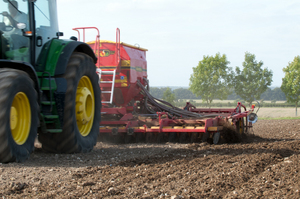Some new houses are being built close to us and there has just been a delivery of bricks. The lorry was large and had an equally large trailer and in-between the two was a mini-crane to lift off the pallets of bricks.
This is quite a coincidence as I was just about to start to write a blog about the impact of field size on time required for cultivations: the basic principles for achieving efficiency in both delivering bricks and cultivations are the same. I’m sorry but this is beginning to sound like the start of a sermon!
It’s all about the absolute rate of cultivation (forward speed x width of the cultivator) or the amount of bricks carried by a lorry adjusted by the amount of downtime. The downtime for both the lorry and the tractor is driving to and from the site, or field, and also the time on the site for the brick lorry to unload or for the tractor and cultivator to turn.
Once the cultivator is in the field, the influence of the proportion of total time spent turning on work rate becomes less important as its value falls. As an example, assume that a cultivator that doesn’t have to turn at all can cover 8 ha/hr. The work rate would fall to 4 ha/hr if it spent 50% of its time turning. Decrease the turning time again by 50% and the work rate would increase to 6 ha/hr, an increase of 2 ha/hr. A further 50% decrease in turning time increases the work rate by 1 ha/hr. So it is the classic law of diminishing returns; as fields get progressively larger the increase in work rate gets progressively less because the influence of the turning time is reduced.
Armed with this principle, I spent a few hours in a field last week measuring the forward speed and width of a cultivator to get the absolute work rate and the turning time to get the level of downtime. I measured turning time by using two approaches and they gave me the same answer, which was a relief. I then calculated the impact of field size on work rate. Naturally you have to make some assumptions on field size and I assumed square fields where the dimensions of the area that can be cultivated were a multiple of the width of the cultivator.
The reason I did this exercise was because I was asked by an organisation interested in biodiversity what was the impact on field size of machinery requirement. Farmland birds do like smallish fields and a mosaic of crops, because this type of countryside provides habitat (more field boundaries), and some bird species don’t like to fly too far from the nest to forage for food. Many will only forage over a distance of about 300 metres.
Bearing this theoretical model for increased biodiversity in mind, the maximum size of field should be about nine hectares, ensuring that one dimension of the field will always be less than 300 metres, and there should be no block-cropping; the approach the industry has taken in order to reduce the journey times to individual fields.
I was asked the same question many years ago and looked at some old Silsoe reports that suggested, in terms of work rate of machinery, that perhaps the ideal individual field size was around 30 hectares (75 acres). As I assumed that this was calculated using smaller tractors pulling narrower equipment than today, I considered it needed updating - hence my ‘time and motion study’.
The result of my study was that the advantage for machinery work rates of having fields above 30 hectares was fairly limited. I tried different scenarios and was surprised how little forward speed or machinery width influenced this conclusion. So the old Silsoe reports are still valid.
The operation I witnessed was a 4.5 metre wide disc and tine machine cultivating stubble down to a depth of around 12 cm with a forward speed of 7.655 kph. By my calculation, it takes around two minutes (or 10%) more time/hectare to cultivate a nine hectare field rather than a 30 hectare field; this doesn’t take into account the extra time spent moving between the smaller fields. Work rate for a 90 hectare field is about 5% higher than for a 30 hectare field.
This increase in work rate between nine hectare and 30 hectare fields doesn’t sound a lot but increasing labour and machinery costs/hectare by at least 10% is by no means insignificant. Plus, smaller fields mean more land and costs devoted to field boundary vegetation, typically hedges, and higher yield losses and management time associated with the increase in the area of headlands. Removing the option of block cropping would result in even higher costs for the farming operation.
In the end, I suppose your view on this information will depend on your view of countryside management. The view of those who wish for more biodiversity in the countryside may be that this is a small price to be paid but, of course, there may well be alternative and less economically damaging approaches to increasing the biodiversity of arable land. These alternative approaches need to be debated and tested.
